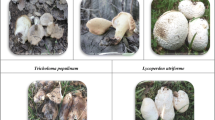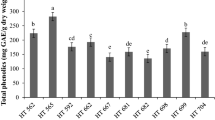Abstract
In this study, nutritional value, free amino acids, phenolic and sugar compounds, mineral and heavy metal contents of truffles, Terfezia olbiensis, and Terfezia claveryi from Turkey were chemically characterized using different analytical methods. In vitro antioxidant characteristics, β-carotene bleaching assay, 2, 2-diphenyl-1-picrylhydrazyl (DPPH) free radical scavenging activity, ABTS cation radical decolorization assay, and the anticholinesterase activities, against AChE and BChE enzymes, were evaluated. Individual phenolic ingredients and free amino acids were analyzed using UPLC-ESI-MS/MS. HPLC-RID was used to assess sugar profile, and ICP-MS was used to determine minerals and heavy metals. Gentisic acid (25.48 and 14.84 μg/kg dry weight (dw)), protocatechuic acid (21.55 and 15.54 μg/kg dw), and p-hydroxy benzoic acid (18.07 and 16.99 μg/kg dw) were quantified in T. olbiensis and T. claveryi, respectively. Rhamnose, fructose, trehalose, and mannitol were the sugars identified. However, T. olbiensis and T. claveryi revealed high amounts of essential amino acids (310.25 and 314.08 mg/100 g, respectively). In addition, the ethyl acetate extracts of the mushrooms performed highest radical scavenging activity, whereas the hexane extracts of mushrooms displayed highest lipid peroxidation inhibitory activity. The results showed that the tested extracts obtained from Terfezia species can be conveniently used as sources for the protection of lipid peroxidation, free radicals, and moderate anticholinesterase agents in pharmaceutic and as food additives for extension of products’ shelf life food and dietary supplement industries. Furthermore, the techniques used in this study were easy, safe, and sensitive.



Similar content being viewed by others
Abbreviations
- ABTS:
-
2,2′-Azino-bis-3-ethylbenzthiazoline-6-sulfonic acid
- AChE:
-
Acetylcholinesterase
- BChE:
-
Butyrylcholinesterase
- DPPH:
-
2, 2-Diphenyl-1-picrylhydrazyl
- DTNB:
-
(5,5′-Dithio-bis(2-nitrobenzoic) acid)
- FCR:
-
Folin-Ciocalteu reagent
- HPLC-RID:
-
High-performance liquid chromatography coupled with refractive index detector
- ICP-MS:
-
Inductively coupled plasma mass spectrometer
- MRM:
-
Multiple reaction monitoring
- QEs:
-
Quercetin equivalents
- PEs:
-
Pyrocatechol equivalents
- SD:
-
Standard deviation
- TIC:
-
Total ion chromatogram
- UPLC-ESI-MS/MS:
-
Ultra performance liquid chromatography with electrospray ionization tandem mass spectrometry
References
Abu-Rabia A (1983) Folk medicine among the Bedouin Tribes in the Negev. The Jacob Blaustein Institute for Desert Research, Jerusalem, p p17
Al-Delaimy KS (1977) Protein and amino acid composition of truffle. J Inst Can Sci Technol 10:221–222
Al-Laith AAA (2010) Antioxidant components and antioxidant/antiradical activities of desert truffle (Tirmania nivea) from various Middle Eastern origins. J Food Compost Anal 23:15–22
AOAC (1995) Official methods of analysis, 16th edn. Association of Analytical Communities, USA
Barrett GC, Elmore DT (2004) Amino acids and peptides. Cambridge University Press, Cambridge
Bokhary MA, Parvez S (1992) Soil mycoflora from truffle native areas of Saudi Arabia. Mycopathologia 118:103–107
Bokhary HA, Sarwat P (1993) Chemical composition of desert truffles Terfezia clavery. J Food Compost Anal 6(3):285–293
Bokhary HA, Suleiman AAA, Basalah MO, Parvez S (1987) Chemical composition of desert truffles from Saudi Arabia. Can lns Food SciTechnol J 20:336–341
Brand-Williams W, Cuvelier ME, Berset C (1995) Use of free radical method to evaluate antioxidant activity. Lebenson Wiss Technol 28:25–30
Carocho M, Ferreira ICFR (2013) A review on antioxidants, prooxidants and related controversy: natural and synthetic compounds, screening and analysis methodologies and future perspectives. Food Chem Toxicol 51:15–25
Chen HK (1986) Studies on the characteristics of taste-active components in mushroom concentrate and its powderization. Master Thesis, National Chung-Hsing University, Taichung, Taiwan
Cuppett SL, Parkhurst AM, Chung W, Weyer M, Bullerman LB (1998) Factors affecting sensory attributes of oyster mushrooms. J Food Qual 21:383–395
Dabbour IR, Takruri HR (2002) Protein quality of four types of edible mushrooms found in Jordan. Plant Foods Hum Nutr 57:1–11
Dundar A, Yesil OF, Acay H, Okumus V, Ozdemir S, Yildiz A (2012) Antioxidant properties, chemical composition and nutritional value of Terfezia boudieri (Chatin) from Turkey. Food Sci Technol Int 18(4):317–328
Ellman GL, Courtney KD, Andres V, Featherston RM (1961) A new and rapid colorimetric determination of acetylcholinesterase activity. Biochem Pharmacol 7:88–95
Fennema OR (1996) Food chemistry. Marcel Dekke Inc, New York
Ferreira ICFR, Vaz JA, Vasconcelos MH, Martins A (2010) Compounds from wild mushrooms with antitumor potential. Anticancer Agents Med Chem 10:242–436
Gutiérrez A, Morte A, Honrubia M (2003) Morphological characterization of the mycorrhiza formed by Helianthemum almeriense Pau with Terfezia claveryi Chatin and Picoa lefebvrei (Pat.). Maire Mycorrhiza 13:299–307
Hiraide M, Kato A, Nakashima T (2010) The smell and odorous components of dried shiitake mushroom, Lentinula edodes V: changes in lenthionine and lentinic acid contents during the drying process. J Wood Sci 56:477–482
Honrubia M, Cano A, Molina-Niñirola C (1992) Hypogeous fungi from southern Spanish semi-arid lands. Persoonia 14(4):647–653
Hussain G, Al-Ruqaie IM (1999) Occurrence in chemical composition, and nutritional value of truffles: overview. Pak J Biol Sci 2(2):510–514
Janakat S, Al-Fakhiri S, Sallal A-K (2004) A promising peptide antibiotic from Terfezia claveryi aqueous extract against Staphylococcus aureus in vitro. Phytother Res 18:810–813
Kawagishi H (2010) Biologically functional molecules from mushrooms. J Syn Org Chem Jpn 68:514–521
Kivrak I, Duru ME, Öztürk M, Mercan N, Harmandar M, Topçu G (2009) Antioxidant, Anticholinesterase and antimicrobial constituents from the essential oil and ethanol extract of Salvia potentillifolia. Food Chem 116:470–479
Kıvrak İ, Kıvrak Ş, Harmandar M, Çetintaş Y (2013) Phenolic compounds of Pinus brutia ten.: chemical investigation and quantitative analysis using an ultra-performance liquid chromatography tandem mass spectrometry with electrospray ionization source. Rec Nat Pro 7:4,313–319
Kıvrak İ, Kıvrak Ş, Harmandar M (2014a) Free amino acid profiling in the giant puffball mushroom (Calvatia gigantea) using UPLC-MS/MS. Food Chem 158:88–92
Kıvrak İ, Kıvrak Ş, Harmandar M (2014b) Amino acid, fatty acid, phenolic, sugar and volatile compounds of Tuber aestivum Vittad. from southwestern Turkey: nutritional value with antioxidant properties. Mitt Klosterneuburg 64:4,216–237
Kӓhkönen MP, Hopia AI, Vuorela HJ, Rauha JP, Pihlaja K, Kujala TS, Heinonen M (1999) Antioxidant activity of plant extracts containing phenolic compounds. J Agric Food Chem 47(10):3954–3962
Mattila P, Salo-Vaananen P, Konko K, Aro H, Jalava T (2002) Basic composition and amino acid contents of mushrooms cultivated in Finland. J Agric Food Chem 50:6419–6422
Miller HE (1971) A simplified method for the evaluation of antioxidants. J Am Oil Chem Soc 48:2–91
Murcia MA, Martínez-Tome M, Vera A, Morte A, Gutierrez A, Honrubia M et al (2003) Effect of industrial processing on desert truffles Terfezia claveryi Chatin and Picoa juniperi Vittadini: proximate composition and fatty acids. J Sci Food Agric 83:535–541
Osawa T (1994) Novel natural antioxidants for utilization in food and biological systems. In: Uritani I, Garcia VV, Mendoza EM (eds) Postharvest biochemistry of plant food-materials in the tropics. Japan Scientific Societies Press, Tokyo, pp 241–251
Öztürk M, Duru ME, Kivrak Ş, Mercan-Doğan N, Türkoglu A, Özler MA (2011) In vitro antioxidant, anticholinesterase and antimicrobial activity studies on three Agaricus species with fatty acid compositions and iron contents: a comparative study on the three most edible mushrooms. Food Chem Toxicol 49:1353–1360
Pietta PG (1998) Flavonoids in medicinal plants. In: Rice- Evans CA, Packer L (eds) Flavonoids in health and disease. Dekker, New York, pp 61–110
Re R, Pellegrini N, Proteggente A, Pannala A, Yang M, Rice-Evans C (1999) Antioxidant activity applying an improved ABTS radical cation decolorization assay. Free Radic Biol Med 26:1231–1237
Reis FS, Barros L, Sousa MJ, Martins A, Ferreira ICFR (2014) Analytical methods applied to the chemical characterization and antioxidant properties of three wild edible mushroom species from Northeastern Portugal. Food Anal Methods 7:645–652
Saltarelli R, Ceccaroli PP, Cesari P, Barbieri E, Stocchi V (2008) Effect of storage on biochemical and microbiological parameters of edible truffle species. Food Chem 109:8–16
Shahidi F, Janitha PK, Wanasundara PD (1992) Phenolic antioxidants. Crit Rev Food Sci 32(1):67–103
Singer R (1961) Mushrooms and truffles. Leonard Hill Ltd., London
Singh RS, Bhari R, Kaur HP (2010) Mushroom lectins: current status and future perspectives. Crit Rev Biotechnol 30:99–126
Slinkard K, Singleton VL (1977) Total phenol analysis automation and comparison with manual methods. Am J Enol Vitic 28:49–55
Stojković D, Reis FS, Ferreira ICFR, Barros L, Glamočlija J, Ćirić A, Nikolić M, Stević T, Giveli A, Soković M (2013) Tirmania pinoyi: chemical composition, in vitro antioxidant and antibacterial activities and in situ control of Staphylococcus aureus in chicken soup. Food Res Int 53:56–62
Streeter JG (2003) Effect of trehalose on survival of Bradyrhizobium japonicum during desiccation. J Appl Microbiol 95:484–491
Türkoğlu A, Duru ME, Mercan N, Kivrak I, Gezer K (2007) Antioxidant and antimicrobial activities of Laetiporus sulphureus (Bull.) Murrill. Food Chem 101(1):267–273
Voita EO (2003) Biochemical and genomic regulation of the trehalose cycle in yeast: review of observations and canonical model analysis. J Theor Biol 223:55–78
Wang S, Marcone MF (2011) The biochemistry and biological properties of the world’s most expensive underground edible mushroom: truffles. Food Res Int 44:2567–2581
Wasser SP (2010) Medicinal mushroom science: history, current status, future trends, and unsolved problems. Int J Med Mushrooms 12:1–16
Yildiz A, Yesil OF, Yavuz O, Karakaplan M (2005) Organic elements and protein in some macrofungi of south east Anatolia in Turkey. Food Chem 89:605–609
Acknowledgments
The author is grateful to Dr. Aziz Türkoğlu from the Department of Biology, Faculty of Science, Muğla Sıtkı Koçman University, for taxonomic identification.
Compliance with Ethics Requirements
This article does not contain any studies with human or animal subjects.
Conflict of Interest
İbrahim Kıvrak declares that he has no conflict of interest.
Author information
Authors and Affiliations
Corresponding author
Rights and permissions
About this article
Cite this article
Kıvrak, İ. Analytical Methods Applied to Assess Chemical Composition, Nutritional Value and In Vitro Bioactivities of Terfezia olbiensis and Terfezia claveryi from Turkey. Food Anal. Methods 8, 1279–1293 (2015). https://doi.org/10.1007/s12161-014-0009-2
Received:
Accepted:
Published:
Issue Date:
DOI: https://doi.org/10.1007/s12161-014-0009-2




